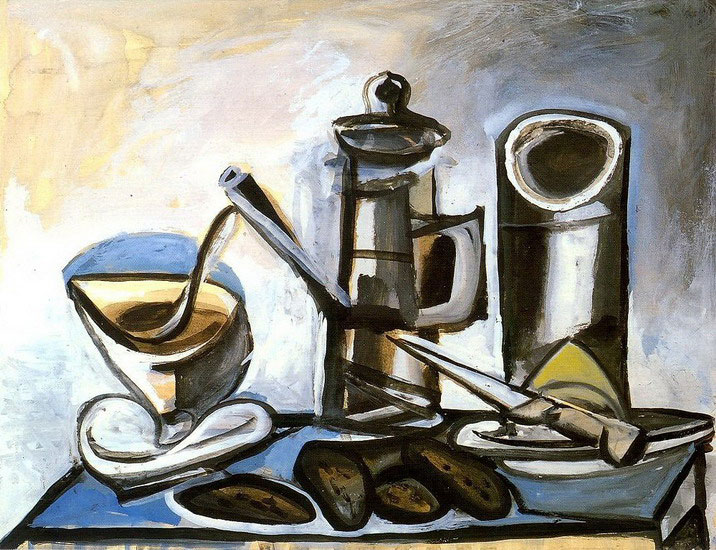KEY WORDS 1: coffee beans, potato chips, peasants, artists

Image: Cafetière, Pablo Picasso (1943)
KEY WORDS 1: coffee beans, potato chips, peasants, artists
by Evrim Emir-Sayers (Paris, France)
FRENHOFER. I saw the name in a Merleau-Ponty text that I read—for the first time—quite a while ago. Of course, as anyone who wouldn’t want to miss a chance to read a Balzac text that Cézanne himself had read and been inspired by, I read it.
Who knew this unassuming little story would inspire not only the pioneers of modern painting, but also philosophers and filmmakers… Cézanne, Picasso, Rivette, Wes Anderson…
Apart from his famous love affair with coffee—
they even sell coffee beans with Balzac’s photo on them at the Maison de Balzac in Paris, which is still not as good as the potato chips with Van Gogh’s potato farmers on them at the Van Gogh Museum in Amsterdam… OK, Van Gogh’s and Heidegger’s love affair with the peasant shoes is another story to be told, but indeed, museum shops can be little trivia troves for the ironic eye as much as they are torture chambers for art works… Oh, those beautiful lilies of Monet on an eraser, or better, on a soda can… But the most astonishing gems are in the children’s section, where you “learn” how to paint like Cézanne through a coloring contour book… What happens to that line liberated by Cézanne in the hands of a greedy money maker? Copy of a copy of a copy… But wasn’t the artist a poet? Not a copyist?
Then again, for what do we need artists? I am still astonished that Plato’s Republic is seen as canon for politics students. A model for the perfect state: the philosopher king, the soldiers, and the peasants. But what about the artists, or the vagabonds? Yes, there is no need for an artist to feed the unfeedables, the Erysichthon. All the potato chips and potato farmers in the world would not be enough…
—I have another thing in common with Balzac: his endless editing sessions…
Apparently, it was none other than our beloved Picasso who used the same studio where Porbus and Poussin welcomed Frenhofer, to paint Guernica. “If only Frenhofer’s own studio hadn’t burned down,” he probably thought. But long before him, it was Cézanne who wrote to his dear friend Émile Bernard, saying: “Frenhofer! C’est moi!” Did Picasso think he was the resurrection of Frenhofer as well? They looked into each other’s eyes and saw the reflection of themselves in each other… Like perfectly polished mirrors. Perhaps.
Mirrors are mysterious things indeed. Especially when you have them in paintings. Yes indeed, long before there was any Modern Art on the northern shores of the Mediterranean Sea, there were mysteries told about mirrors, in Asia, tying them to painting. Mustafa Ali talks about the story of Mani, or Rumi about Greek and Chinese painters. While the Chinese paint their walls, the Greeks polish theirs to create a mirror. One might read this as a sort of anti-colonial story, saying yeah, nice goal for the East. But we can also read it as a story that unites rather than separates. Let’s say when they get rid of the curtain between the rooms, they see that they reflect each other, they are not different, better, more vulgar than the other… Where do you close or open the curtain? When do you set the line, the contour? The contour that separates or the one that unites? Those little stories, those little gems, right?
So let’s go back to our own little story, the story of Frenhofer.
For every brush stroke, he took days (hours for us—Oh Rivette, thank you soooo much for giving us the most intimate of moments… The most holy, perhaps… The ultimate voyeurism: watching the artist closely, slowly, privately, like a ghost in the studio, in his temple). And yet, see, he is not a copyist… He is a peasant. He has peasants’ hands: not the hands of Rubens, but those of Cézanne. Oh, how clean those museums are. His studio is messy—not as “messy” as Francis Bacon’s, but neither sterile like a museum of modern art. Sometimes, when I enter one, I feel like I’m inside a morgue, identifying dead art, or rather l’art mort. I’ve never been to the twin of the Kunsthistorisches Museum in Vienna, the Natural History one, but I always imagine it having the same effect: some dead butterflies on display. For some reason, one thinks there is something not quite right going on here. Pointing out that thing is not an easy task. Still, our beloved Frenhofer manages to finish his sublime Noiseuse, yet only delivers the belle Noiseuse to the public eye.


Responses